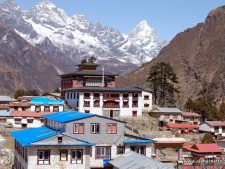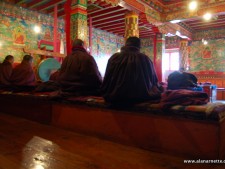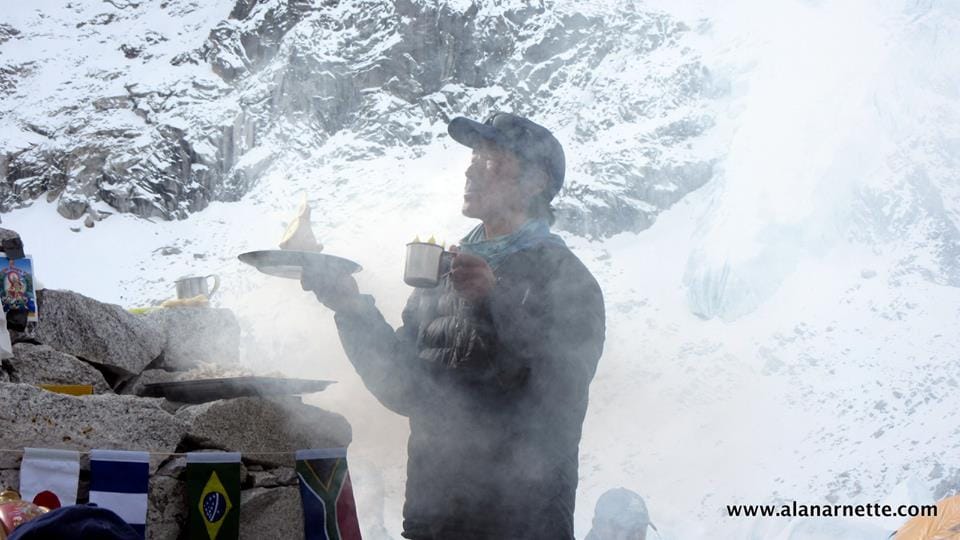
The teahouses are overflowing in the Khumbu as teams continue the migration towards Everest Base Camp (EBC).
The early teams are now about midway through the trek while others just left Kathmandu yesterday. And some have not even arrived in Nepal.
Some teams climbing from the north side will trek the Khumbu and climb a 6, 000 meter mountain for acclimatization due to the Chinese not opening their border until April 9th.
Leaving home is one of the most difficult parts of an Everest climb. Robert Kay says it well as he prepared to leave the US:
I’m excited to get to Kathmandu, drugstore my home away from home, and reunite with all my good friends there. I am also looking forward to eating at my favorite restaurants (The Third Eye, Thamel House, Pujan’s steaks, etc) and walking around Thamel looking at thangkas (a Tibetan and Nepalese art that I love). I am not looking forward to the goodbyes that also come with a long trip. It is tough to not see your family for two months.
And Georgina Miranda, posted this in mid travel:
After getting through security I was a bit of a sappy mess as it finally hit, that this all really was happening, it wasn’t just a dream, and that I was off to an incredible journey, for a great cause, and to push my limits once again and see what mother nature has in store for me! It was pretty emotional, and although it is sinking in as I sit here in Bangkok for my final flight, it still feels a bit surreal and maybe it won’t really hit until I land in Lukla and start walking through the Himalayas 🙂
However, once they arrive in Nepal, the adventure begins. David Tait, one of my all time favorite Everest writers during his climbs posted this as he arrived:
But it’s Kathmandu. Nothing will ever change or improve here, and that’s why I love it.
David’s posts are rich in emotion and detail as is his cause to end child abuse. If you only read one blog from the mountain throughout Everest 2013, David’s might be the one.
Tengboche Monastery
One of my favorite memories during the trek in, is the visit to the Monastery in the village of Tengboche.
First built in 1923, it was destroyed by an earthquake in 1934 and by fire in 1989. Today it has been rebuilt and serves as home to around 100 monks.
Some teams spend two nights in the area thus allowing time to attend morning or evening prayers by the monks.
You climb the steep stone steps and enter the dirt courtyard. Looking at the red and yellow windows brings a sense of serenity even before you enter the Monastery proper. Taking off your shoes, you step high across the threshold taking a moment to let your eyes adjust to the darkness combined with the filtered sunlight entering the narrow windows.
A young monk with his short cropped hair, smiles and waves you to his left. An invitation to participate but according to their rules. One by one you softly walk across the well-worn wooden floor and take your place on the thick woven mats spread across the floor. Some choose to sit cross legged, other use the hard wall as a backrest. It is cold.
Your eyes now adjusted, you look around. A huge Buddha, looming behind the alter looks over everyone. Butter lamps provide a soft glow with their flickering flames. The ceiling is tall, everything created by hand, the murals ly hand painted by monks who journeyed from Tibet to rebuild the Monastery. You are looking at history, at tradition.

Soon the monks enter the room and take their place on short benches also layered with thick Tibetan rugs. They look warm in their crimson robes, while you shiver in your down jacket.
Silence fills the room until a deep chant begins followed by a harmony of baritones from the monks. The chanting is soft and easy. It is soothing. You are lost in your own thoughts, closing your eyes to let the moment sink in.
Suddenly, you are awakened from your trance by the shocking sound of a deafening drum beat, then the clash of a symbol. The monks don’t flinch.
After a while, they take a break as the youngest amongst them serves the elders tea. You look on with envy.
The chanting continues but it is time for you to move on. Leaving the Monastery, the sun is bright. The high Himalaya surrounds you. Ama Dablam looks down on you, Everest in the distance.
Perhaps you have found your own Monastery.
Shortcuts
As I said earlier in this post, leaving home for two months is tough, very tough. You have to be clear on your purpose to be away from family that long. For me, the trek through the Khumbu has always been as much a meaningful part of the experience as the climb itself. I have made that trek six times and it never gets old.
But for some climbers in search of shortcuts, they are ing to shorten the trek, and the experience.
Alpenglow is offering a 45 day Everest schedule for 2013. This compares with 60 to 71 days by the other commercial teams. One way they are reducing the schedule is by taking a helicopter to the village of Lobuche at (16,210’/4940m) and then acclimatizing on Island Peak (20,305’/6189m), including two nights on the summit.
This will reduce at least two rotations through the Icefall and the team will spend one week at Camp 2 instead of the normal two night schedule plus one at Camp 1 over two rotations through the Icefall. The members will take a helicopter out from EBC after the summit attempt.
In speaking with Alpenglow’s owner, Adrian Ballinger, he is ing to meet the requests of busy members. In addition to spending less time on the mountain itself, his members are spending four weeks sleeping in altitude tents at home before they arrive in Nepal.
Once at EBC, his team will climb the Icefall to Camp 2, spend a night at Camp 3 before returning to EBC until the summit window. They will use supplemental oxygen at 4 lpm from C3 onward.
I asked Adrian about the spirit of mountaineering and if his approach breaks that spirit and encourages “peak bagging”. Adrian responded:
Absolutely not. I hope it opens the opportunity to climb a peak like Everest to some people who in the past could not take a full 2 1/2 months away from family, work, or other obligations. I do not believe it will cause an erosion of the spirit of mountain climbing. Our climbers will still have to train extensively, dedicate time and effort to preparation, perform at a high level throughout the expedition, and form strong partnerships with their teammates.
They will be challenged physically and mentally by the climb and the mountain. I believe these are the key components of the spirit of mountaineering, and they remain true for an expedition to Everest whether it begins from a faraway ocean and takes months, or utilizes modern technology to fly into Lukla or Lobuche or beyond.
Adrian is not only ambitious as he leads his first expedition on Everest and Lhotse as an independent guide (he previously worked for Himalayan Experience) but he also is aiming to ski down from the summit of Lhotse, if conditions allow. Adrian’s company, Alpenglow has been guiding to the Alps, South America and the Himalayas, but not Everest, for many years.
What Alpenglow is attempting is not unheard of. Professional mountaineers like Ulie Steck or Chad Kellogg spent weeks climbing 6000 and 7000 meter mountains in the Khumbu before heading to Everest for a “quick” climb. Acclimatizing on Lobuche, Kala Patar or Island Peak is also common with teams such as Himex, IMG and Peak Freaks.
My own opinion is that climbing Everest is an opportunity of a lifetime and something not to be rushed through. Yes, seven or eight or nine weeks is a long time, requires commitment, dedication and sense of purpose; but to rush through to tick the box misses the point.
Climb On!
Alan
Memories are Everything



12 thoughts on “Everest 2013: The Long Way to Base Camp”
I stumbled on your page by accident and am completely memorized. In not a climber and have never thought of becoming one but your blog is making me reconsider. This year my wife and I and 8 month old son will tackle Mount Brunswick, the highest peak in the Lower Mainland (Vancouver region in BC Canada). At 1,788m it’s certainly not Everest, but it’s a start! Thanks for your great stories and coverage!
That should say mesmerized :).
I would love to trek to Mount Everest base camp one day, for me I would go to the North side because I have an interest in the old British expeditions.
A great read Alan, really makes me want to be there now!
Colin
Please take a look at Mount EverestThe British Story to learn about the British on Mount Everest.
I just love your blogs, this one made me feel quite emotional, don’t know why.I understand where Adrian is coming from but it’s rather sad to miss out on perhaps the best bit of an Everest summit. I suppose if that is the only way you know your circumstances will allow then I would say ‘go for it ‘. I agree David’s blogs are great and they are amongst the ones I store away for the winter months. I could smell the atmosphere in the monastery Cheers Kate
Nice post , Alan. As the D Day is approaching ,Iam all charged up to see how the weather in Everest behaves this year. All the Best , guys, for a safe climbing & safe return home.
having been to bc three times I am reliving the super experience through your blog.
Oh and all the best to David Tait. He’s own story is amazing,if people want to check it out. And he works tirelessly for the NSPCC who do amazing work for abused children in the UK
On point as always Alan 🙂
Adrian’s full interview with Alan can be found here: http://alpenglowexpeditions.com/blog/full-interview-alan-arnette
Wishing you and the team all the best Mike.
Adrian is a pioneer in the climbing world! I’m looking forward to watching and to joining him as he breaks the mold!
Wise words Alan as usual. Well done!
Comments are closed.